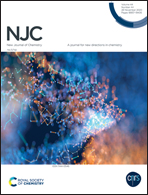Electrocatalytic behavior of a heterostructured nanocomposite sensor for aminotriazole†
Abstract
Aminotriazole (AT), an organic heterocyclic compound, is an unselective herbicide used to deal with a large assortment of weeds by preventing the biosynthesis of carotenoids. It is a malignant agent to human beings as well as to animals. This study is focused on the nanomolar detection of AT with multiwalled carbon nanotubes along with calcium-doped zinc oxide nanoparticles adapted for a nano-composite dependent glassy carbon electrode (MWCNTs/Ca–ZnO/GCE). The developed MWCNTs/Ca–ZnO/GCE showed an excellent electrocatalytic response to AT in 3.0 pH of 0.2 M phosphate buffer solution (PBS). There was an increase in the peak current of AT, i.e., 7.726 μA, with MWCNTs/Ca–ZnO/GCE when it was compared with the peak current of AT at the bare glassy carbon electrode (GCE), 3.478 μA, due to the semiconducting properties of the doped nanoparticles. Various techniques were employed to study the different parameters such as scan rate, pH variations, and concentration variations by cyclic voltammetry (CV), square wave voltammetry (SWV), and linear sweep voltammetry (LSV) in order to probe the mechanism, number of participating electrons, type of process, detection limit, and quantification limit. The Ca–ZnO nanoparticles (NPs) were synthesized at the proportion of 5.0% and these were characterized by energy dispersive X-ray analysis (EDX), scanning electron microscopy (SEM), transmission electron microscopy (TEM), and X-ray diffraction (XRD). The developed sensor was applied for real sample analysis like soil and water by quantifying the AT in the samples and the output was found to be precise with good recovery results.



 Please wait while we load your content...
Please wait while we load your content...